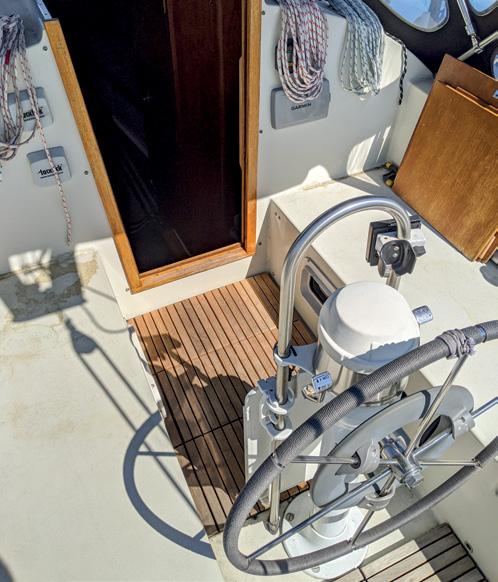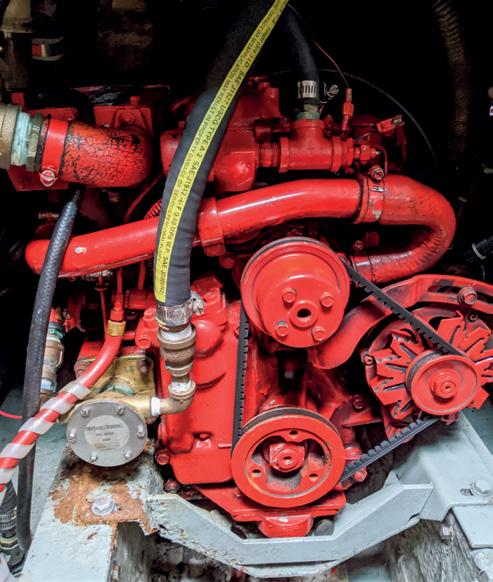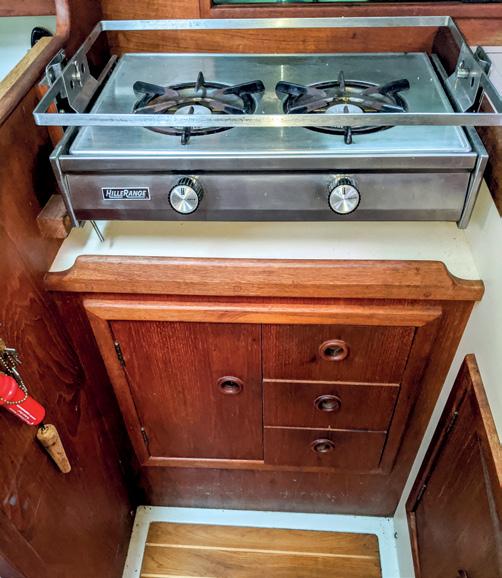
10 minute read
Galley Essentials with Amanda
24 Galley Essentials
PROVISIONING FOR A CHARTER ADVENTURE
by Amanda Swan Neal
This month, we’re excited to be conducting sail-training expeditions in the Pacific Northwest that mark a few firsts for us. Not only are we sailing through our home islands of the San Juans from Bellingham out to the ocean and back, we’re also sailing on Misty, a chartered Jeanneau Sun Odyssey 45.1 from San Juan Sailing.
Because we’re not on our own equipped expedition boat, Mahina Tiare, which is waiting for us in New Zealand, there’s plenty of planning involved. So, I thought I’d share my provisioning tips. Although we’re chartering, I’m thankful that we’ll be driving to the vessel rather than flying, making it possible to take some pre-purchased provisions.
1. THE BIG PICTURE
Like most projects, it’s important to define the variables. First, establish the itinerary; a 7-day sail-training expedition with an overnight passage between 160 to 220 miles. Next is the number of crew—eight—and we’ll need to take allergies and preferences into consideration. Lastly, determine who will do the cooking; that will be John for breakfast and myself preparing lunches and dinners with the help of the crewmember who is on galley duty for the day.
2. MEAL PLAN
The fridge and freezer size determine the amount of fresh and frozen provisions that can be strategically stowed in their spaces, versus the amount of provisions that need to be shelf stable. If time permitted, I’d precook some meals; but as we’re going back-to-back with the expeditions, this won’t be possible. I’ve created a 7-day dinner meal plan and have written up the recipes with the required amounts so they’re easy to follow. I opted for simple meals with straightforward ingredients that have been tried and tested on our South Pacific expeditions.
3. SHOPPING
The menu plan allowed me to create a comprehensive grocery list. I’ve planned four shopping excursions, which started with my local supermarket. I purchased bulk spices to create Mexican, Moroccan, and curry spice mixes along with acquiring my favorite salad dressing, hot sauces, and bulk dry goods. An early Costco run is next for shelf stable provisions plus freezer items; and on the day of our charters, we’ll again shop at Costco and Safeway for dairy items, bread, fruit, and vegetables.
4. ORGANIZING
Once aboard, efficient stowing of items will be the highest priority. I use Ziplock bags for organizing the freezer items and layer them according to the menu plan. Fifteen-quart lidded tubs keep items organized in the fridge. We’ll also bring containers for lettuce, tomatoes, and an open container for commodities such as milk, butter, and cheese. We’ll establish a condiments locker and then stow the remaining items about the boat in relation to the menu plan and storage allocation.
5. HYDRATION
Hydration is key to avoiding seasickness and staying brighteyed and bushy-tailed. Everyone will have a labeled 1-liter square Fiji water bottle that can be easily stowed in the cockpit and taken to their bunks. This makes getting drinks for the onwatch easy, plus there’s no need to use water for washing up cups. We’re supplying thermos mugs for everyone and a 2-quart top plunger thermos that we’ll position in the galley and keep full of hot water for drinks.
6. SPECIAL ITEMS
Our favorite go-to items, including knives, zester, cheese slicer, grater, and a tray for serving lunch sandwich makings will also be brought aboard. Charterers can’t count on satisfying people have different cravings at different times. We keep a well
inventory or quality of these essentials, so if you have the life upgrade.
7. EXTRA TIPS
When you’re boiling water for pasta, also add some eggs to hard boil for lunch the next day.
Lettuce is best stowed in a container with a damp paper towel in the bottom. When creating a salad, also use cabbage and just peel off the outer leaves of both the cabbage and lettuce as opposed to cutting through the layers.
Stow fresh ginger in the freezer and grate as needed.
Snacks, both salty and sweet, are essential to have because opportunity to bring your own, it can be a serious quality of
stocked fruit bowl in the galley plus a container in the cockpit for snacks that may include crackers, granola bars, cookies, pretzels, nuts, and dried fruit. Sometimes in the late afternoon, John will cook up a batch of popcorn, which is always welcome.
This month Amanda is sailing three ocean sail-training expeditions in the Pacific NW. Follow her adventures on www.mahina.com.
The following recipes are likely to be served aboard Misty, with the Sweet Potato Salad having had a test run on a recent boating trip to Sucia Island and the fish being served by a good friend. roast for 15-20 minutes. Let cool and peel off the skins.
BIRCHER MUESLI
This is a popular brekkie in New Zealand, Australia, and Europe. Soaking your oats releases minerals and enzymes that increases their nutritional value and makes them more easily digestible. The background story is that around 1900, Swiss doctor Maximillian Bircher-Benner made Bircher Muesli part of a healing therapy treatment for his patients. 2 cups jumbo rolled oats 1½ cups apple juice 2 apples yogurt seed mix - pepitas, sunflower or flax seeds nuts - my favorite is walnut fresh berries or dried fruit
In a medium bowl, combine oats and juice. Cover, and leave in the refrigerator overnight. In the morning, grate the apples (including the peel) into the muesli. Serve with toppings. Serves 4.
SOUTWESTERN GRILLED SWEET POTATO SALAD
1 lrg sweet potato – lrg cubes 1 tbsp olive oil 1 tsp salt 1 tsp pepper 1 tsp ground cumin 2 ears sweet corn, husks removed 1 15oz can black beans 1 red bell pepper - diced 1/2 red onion - diced 2 sm jalapeno peppers - chopped 1/2 cup cilantro - chopped juice of 3 limes
Prepare gas grill. Toss sweet potatoes in olive oil and 1/2 teaspoon each, salt, pepper, and cumin. Grill 3 minutes, flip, and grill until soft. Meanwhile, grill corn on all sides until tender-crisp. Slice the
BAKED HALIBUT
4 halibut steaks 2 tbsp chopped roasted red pepper 2 tbsp butter 1 tbsp olive oil fresh dill salt and pepper
Preheat oven to 450°F. In a small pan, simmer butter and roasted red pepper until well combined. Arrange halibut in a greased baking dish. Spoon over red pepper mix, add dill and season to taste. Cover with foil and bake 15 minutes. Serve with salad and potatoes.
ROASTED RED PEPPERS
Place halved red peppers on a foil-lined baking sheet, cut side down. Place in oven, 4 inches from the broiler, and corn off the cob once cooled. In a bowl combine all ingredients.
NO BAKE ENERGY BITES
½ cup dried cranberries - chopped ¼ cup walnuts - finely chopped 1 cup unsweetened coconut flakes ½ cup rolled oats ¼ cup ground flaxseed ¾ cup unsalted almond butter ¼ cup maple syrup
In a large bowl, combine first five ingredients. Add almond butter and maple syrup. With your hands, roll and press 2 tablespoons of mixture into balls.
Nonsuch 26

A Nonsuch sailboat is not an unfamiliar sight around the Salish Sea. Yet, this unique design deserves some further consideration, to say the least.
The first unmistakable feature of any Nonsuch is the hefty, unstayed mast. The boat is cat-rigged, so the tapered aluminum mast is positioned very near the bow and must only support a large, single mainsail controlled by a wishbone boom system. Like the tapered masts of the Nonsuch 26’s smaller cousins (cat-rigged dinghies like the Laser, Finn, and RS Aero, and the sloop-rigged 505 — all have tapered masts), the narrower section at the top serves an intended purpose: in puffs, the top of the mast bends slightly off to leeward, spilling sailpower aloft, and helping keep the boat ably on its feet. The lack of stays contributes to an unusually clean deck and interior.
To say the Nonsuch 26, which was built by Hinterhoeller Yachts in Ontario, is stout is an understatement. Tipping the scales at 8,500 lbs.—of which 2,750 is in the fin keel—the Nonsuch 26 is a bit heavier than many of its pocket-cruising counterparts. But don’t let that fool you. Sailors genuinely praise the boat’s performance, including in light air; and the quality of the build—from fiberglass layup to the finish work— has kept Nonsuch boats in a class apart from most competitors in terms of desirability and resale value.
Indeed, for sailing performance, one need look no further than the genesis of the design itself. The Nonsuch 26 was designed by Mark Ellis. The 26 is Ellis’s second Nonsuch design after the debut of the 30-foot version (he went on to draw additional Nonsuch sailboats in 22, 32, 33, 36, and 40-foot lengths). The point of note, though, is that the entire Nonsuch line came from the commission of a retiring Canadian racing sailor, Gordon Fisher, according to the International Nonsuch Association. Central to the design brief was the principle that the boat should not only be easy to single-hand, but it was also to be fast. You can take the sailor out of the race, but you can’t take the race out of the sailor!
Experienced Nonsuch sailors point out that there are some adjustments to technique and mindset for those coming from the more common sloop, but the performance is sure to impress. Much of this is thanks to the malleability of the loosefooted mainsail shape and its wishbone boom system. Boom-
SAILING IS A BREEZE WITH PERFORMANCE, COMFORT, & EASE


SPECS:
LOA: 26 feet LWL: 24.42 feet Beam: 10.5 feet Displacement: 8,500 lbs. Ballast: 2,750 lbs. Draft: 4.5 feet


SPECIFICS OF THE 1981 NONSUCH 26 Offered For Sale by Northwest Maritime Center
Reliable Westerbeke 15hp diesel 24 gallon diesel tank 60 gallon freshwater tank 25 gallon waste tank Propane 2-burner stove Enclosed head and shower All control lines run aft to the cockpit
Price: $25,000 Contact: kris@nwmaritime.org
end sheeting keeps mainsheet loads low. The single wishbone boom control line, called “the choker,” moves the clew down and aft when trimmed or up and forward when eased. The result is a shape that can be deep and round for power (choker eased) or flat and efficient when sailing in bigger breeze (choker trimmed). Slab reefs allow for further control.
The downward sloping angle of the boom (higher at the mast, lower at the clew) has been carefully calibrated such that a down-pressure function, much like a vang, is naturally a part of trimming. Also contributing to the boat’s better-than-expected performance, the Nonsuch 26 has a long waterline length for its length overall compared to many designs of the same era.
True to the design priority of ease for shorthanded sailing, the Nonsuch set a new standard for shorthanded simplicity. Tacking? Turn the wheel. That’s it. With everything thoughtfully rigged and run back to the comfortable cockpit, a single-handed sailor has ease aplenty. The wishbone boom’s attributes require only a couple of control lines. Without a jib or genoa, visibility is excellent. And, with controls for the 15-horsepower Westerbeke on the steering wheel binnacle, docking utilizes the systems of an unwieldy larger boat in a smaller more managable package.
Speaking of large-vessel-characteristics in a small package, the Nonsuch 26 is just plain comfortable, especially for its size. If there’s a larger interior in a 26-foot sailboat, I haven’t seen it, especially not on a boat you’ll actually enjoy sailing. The boat’s 10.5-foot beam, which carries well aft, helps accommodate this. Standing headroom (yes, you read that right) can be found throughout the interior, as well as spacious sleeping accommodations for four in four single berths. A highly functional galley can be found to port amidship, opposite the enclosed head cabin to starboard. While the boat is dead easy to for one person to sail, the interior could be a very happy home for a small family or group of friends for a week (or more) of blissful island cruising.
In many ways, the Nonsuch 26 was well ahead of its time: long waterline, wide beam carrying aft to afford greater interior space, and sailing systems centered on ease—all this while providing an enjoyable sailing experience and an elegant visage from every angle. It’s no wonder the demand for these big little boats remains so high!









